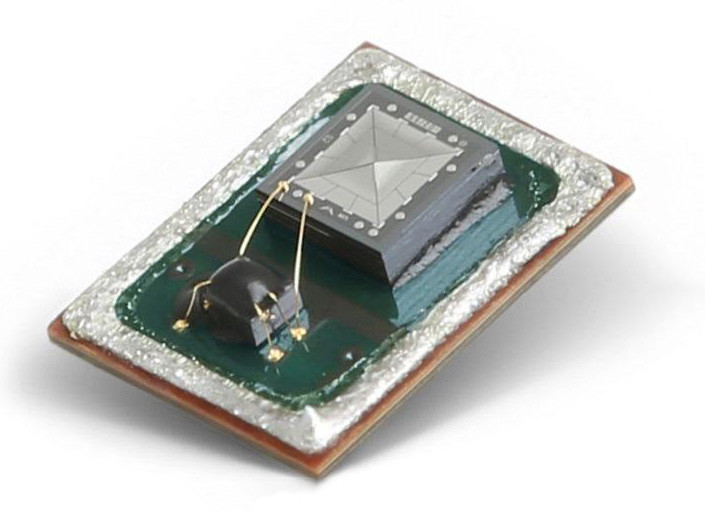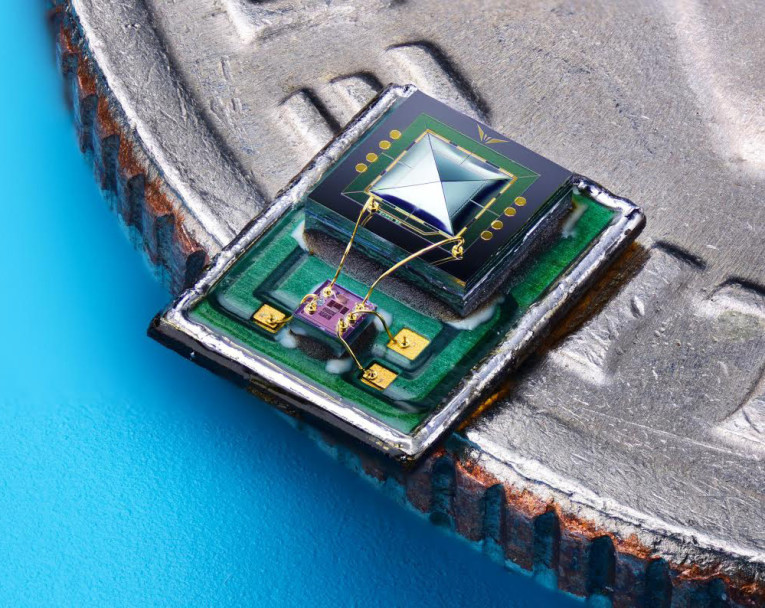
Since 2009, Vesper has built a broad and deep patent portfolio around its proprietary piezoelectric technology, which works quite differently from conventional capacitive MEMS microphones. Instead of a traditional diaphragm, which requires a perforated back plate that creates self-noise via squeeze film damping between the back plate and the diaphragm, Vesper’s piezoelectric transducer is square and divided into four triangular cantilevers, in the shape of an “X” cut between opposite corners with just enough space between them that they never touch (see Photo 1).
The piezoelectric cantilevers rise and fall in response to the sound coming in its port that produces the electrical audio signal (see Figure 2). The piezoelectric material is also immune to environmental contaminants such as water (including surfactant-laden fluids such as soapy or salty water), dust, and particulate matter. The robust quality of the piezoelectric material is unique as such contaminants reduce sensitivity in both legacy electret condenser microphones (ECMs) and conventional capacitive MEMS microphones.
Applications for microphones are diverse, spanning the extreme high volumes of smartphones, headsets, and earbuds and medium volumes in gaming, virtual reality headsets, video cameras, and laptop/notebook computers. Internet of Things (IoT) devices, smart home appliances, home and commercial security systems, wearables/hearables, autonomous/partially autonomous vehicles, and drones are also emerging as future high-growth applications for MEMS microphones.
As voice interfaces become increasingly mainstream, the size and the diversity of the market will only grow. And, it’s not just the number of microphone-using products that is rising. It is also the number of MEMS microphones per product, which manufacturers use in an array. For example, the top smartphones use between four to five MEMS microphones. Amazon Echo uses seven, and we are still in the early days of microphone arrays for consumer products.
With such a proliferation of these pencil point-sized devices (see Photo 2) embedded in the electronic products that so many of us use on a daily basis, it is no surprise that microphone suppliers are doing whatever they can to outperform the competition.


Evolutionary Path
A MEMS microphone usually consists of a capacitive microphone element, which is connected to an Application Specific Integrated Circuit (ASIC) functioning as an internal preamp. Both the microphone element and the ASIC are assembled and wired into a surface-mount package (SMT).
Knowles introduced one of the first commercially produced MEMS microphones almost 25 years ago, a micro-miniature capacitive topology. While there were another dozen early developers of condenser MEMS microphones, most did not survive to maturation or were acquired. MEMS microphone audio-performance development has been problematic. For decades, those early fabrication processes required many critical steps that were poorly controlled, and the acoustic characteristics were inferior to existing microphone technologies. It has only been within the last five years or so since that it has all really come together for the MEMS microphone industry.

The ECM vs. MEMS Microphone Performance Race
ECMs — a type of capacitor microphone that Gerhard Sessler and Jim West invented at Bell laboratories in 1962—dominated the microphone market for more than 40 years until MEMS microphones overwhelmed them.
Let’s look at the ECM vs. MEMS microphone statistics around 2010. The MEMS microphone’s signal-to-noise ratio (SNR) was historically inferior to that of ECMs. Five years ago, most ECMs could reach 60 dB SNR and some a bit beyond, yet the typical MEMS microphone could not reach beyond 55 to 58 dB SNR. Back then, ECMs delivered a higher acoustic overload point (AOP) than MEMS microphones before distortion, around 125 dB. In fact, MEMS microphones were especially vulnerable to high sound levels and wind saturation distortion. Dust and fumes, not just from the surface-mount soldering process but from normal operation in the field in mobile audio products, were also past challenges for many MEMS microphone vendors.
From a commercial standpoint, many vendors offered ECMs, enabling multi-sourcing, and they were less expensive than MEMS microphones. Until three to four years ago, Knowles commanded the lion’s share of the decent performance MEMS microphone market. This was the result of its patent position and supply capability. Specifically, Knowles had several packaging patents, which it effectively enforced. The lack of a viable second source stymied adoption.
But the competitive market has dramatically evolved in the last five years with the MEMS microphone tsunami enveloping consumer products. Today, MEMS microphones have more than a 60% market share and are rapidly taking over what remains of the ECMs’ share. According to business information provider IHS Markit, the market should rapidly grow to exceed 5.5 billion MEMS units by 2019. In addition, up to eight MEMS microphones are being used in some modern automobiles, seven in the Amazon Echo, four or five in next-generation smartphones, and smaller numbers in cameras, camcorders, hearing aids, Bluetooth headsets, wearables, and all types of IoT products.
Today, STMicroelectronics, InvenSense, Infineon, Hosiden, GoerTek, AAC Technologies, and others share the capacitive MEMS microphone market with Knowles, and pricing is comparable to ECMs. Commodity capacitive analog MEMS microphones deliver at least 60 dB SNR, and 63 to 65 dB SNR is readily available on higher-performance MEMS microphones. Approximately 70 dB SNR is targeted by the best MEMS capacitive analog microphones, such as the InvenSense ICS-40720. But, its form factor and power consumption exceed the requirements of most mobile consumer electronics.
The new piezoelectric MEMS topology roadmap now calls for the 70 dB version, followed by an ultra-miniature low-power 72 dB model in 2017 and a 75 dB model by 2018, which is unheard of for non-professional microphones. Digital capacitive MEMS microphones typically deliver a few less decibels SNR and lower AOP than their analog counterparts.

Dynamic Microphones vs. Legacy MEMS Microphones
Dynamic microphones still have the majority of stage and field applications due to their physical robustness and extreme acoustic tolerance of intense sound levels. A dynamic microphone typically consists of a thin film diaphragm, attached to a voice coil in a magnetic structure (see Figure 3).
The high sensitivity of dynamic microphones delivers excellent SNRs but the high-moving mass of dynamic microphones makes them more vulnerable to handling (microphonic) noise, requiring competent special care in the design and construction of the complete microphone assembly/isolation shock mounting. Compared to dynamic microphones, MEMS has a higher noise floor, and inferior acoustic overload point.
Capacitive MEMS microphones are not as robust or stable as dynamic microphones, although we can expect to see the progressive introduction of piezoelectric MEMS microphone into new designs. Condenser and ribbon microphones are typically used for studio recording applications where only the highest performance is a must and will remain beyond MEMS microphones’ reach for the moment.
Piezoelectric MEMS microphones will most likely disrupt premium applications such as broadcast, electronic news gathering, stage, prosumer (e.g., karaoke, DJ, and project studios), and commercial sound from paging to teleconferencing, head-worn, and lectern gooseneck, as well as enhance the longterm stability of microphone arrays.
Piezoelectric MEMS Product Design
Let’s also look at the range of MEMS microphone formats and Vesper’s Product Development Roadmap to see what other attributes might come in handy for product designers. MEMS microphones come in a range of formats from bottom and top ports, analog single-ended and differential and digital PCM and I2S. Be sure to check out my article on How to Select MEMS Microphones for background information on what is different on MEMS microphones when transitioning from ECMs.
Vesper’s first mass-production offering, VM1000, is single-ended analog output and uses a bottom port, but top-port designs are in the making and just a packaging variation. Also, now sampling is Vesper’s VM2000, a fully differential analog bottom port microphone. Long runs and high RFI noise immunity are strengths of piezo-MEMS microphones. The piezo topology manages GSM/TDMA burst noise better and provides wide-band radio frequency noise suppression and power supply ripple rejection.
VM2000 especially promises better noise immunity performance over capacitive pseudo differential and differential output conventional MEMS microphones due to the topology of four piezo cantilevers in a differential 2 × 2 configuration all the way through — along with good low voltage operation.
Piezo MEMS microphones avoid the need for a charge pump enabling superior immunity to power supply ripple. Power supply ripple rejection on the Vesper microphones is in the top of their class not just on paper and in some applications, the only real-world workable analog MEMS microphone solution. Aside from physical robustness and superior audio performance there is the added benefit of the piezo MEMS microphone’s high noise immunity — an excellent defensive engineering approach, potentially avoiding or minimizing PCB layout tweaking reiterations.
For more information about Vesper Technologies, visit www.vespermems.com. VC
AAC Technologies and Vesper Technologies
A couple questions that hung over Vesper Technologies when it initially launched were whether this technology was real and would Vesper have the staying power to be a viable commercial vendor. With its recent partnership with AAC Technologies, it seems Vesper is here to stay. Competition in the MicroElectroMechanical Systems (MEMS) microphone market is fierce. Even Knowles with its incumbent dominance in MEMS microphones, is losing some of the market share to its competitors, including STMicroelectronics, AAC, InvenSense, GoerTek, and other big players.

Changing Vesper’s odds is AAC, the world’s largest microspeaker vendor, which chased Knowles out of the microspeaker business this year and is a major MEMS microphone vendor in its own right. AAC’s involvement with Vesper is comprehensive, from financial investment to dicing its wafers and packaging its microphones as well as handling some sales to the smartphone and other tonnage markets. AAC already sells its own MEMS microphones in high volume to original equipment makers worldwide and has added Vesper’s piezoelectric MEMS microphone to its catalog.
 Even with AAC backing them, Vesper still needed a strong semiconductor foundry for the critical fabrication of the piezo-MEMS microphone element. At the start of 2016, Vesper announced its collaboration with GlobalFoundries, one of the largest and most advanced foundries and a pioneer in piezoelectric MEMS manufacturing. Piezoelectric MEMS processing technology is sophisticated with existing applications in energy efficient tunable radio frequency front-end antenna systems for mobile devices.
Even with AAC backing them, Vesper still needed a strong semiconductor foundry for the critical fabrication of the piezo-MEMS microphone element. At the start of 2016, Vesper announced its collaboration with GlobalFoundries, one of the largest and most advanced foundries and a pioneer in piezoelectric MEMS manufacturing. Piezoelectric MEMS processing technology is sophisticated with existing applications in energy efficient tunable radio frequency front-end antenna systems for mobile devices.The future is exciting, not just for Vesper but for audio product designers of broadcast and stage headworn microphones, electronic news gathering (ENG) microphones, stage microphones, conferencing, and stable precision microphone arrays as well as for the pro-sumer microphone markets. Microphone designers now have the option of a unique miniature microphone element that is far more compact than a dynamic or even electret condenser microphone (ECM) element, and offers stable real-world performance in microphone arrays as well as a low noise floor. This new alternative is also waterproof and highly robust, and provides high radio frequency interference (RFI)/electromagnetic interference (EMI) and handling of noise immunity.
 Interview with Matt Crowley
Interview with Matt CrowleyVoice Coil met with Matt Crowley, CEO of Vesper, to get a hint of what is coming for MEMS microphones. Crowley prefaced the conversation with the Vesper Promise: “We are just beginning to realize the potential of piezoelectric MEMS microphones, whereas our competitors using capacitive MEMS transducers are facing very limited options for further refinements.”
Mike Klasco: Why would the piezoelectric microphones enable applications that were previously impossible for capacitive MEMS microphones?
Matt Crowley: The SNR of traditional capacitive MEMS microphones is limited by the need for a perforated back plate behind the diaphragm. Piezoelectric transducers have a very different topology from capacitive diaphragms since piezoelectric transducers do not require a perforated back plate, which can degrade about 8 dB SNR to the microphone’s self-noise.
The piezo MEMS microphone has a single layer diaphragm, where capacitive MEMS microphone topology has two layers — a diaphragm and back plate. And that leads to reliability problems.
Because we don’t have the tiny capacitive gap where water or particles can get trapped, our product is not vulnerable to water, dust and vapors.
Another advantage of the piezo MEMS microphone is that it doesn’t require a bias voltage from a charge pump. We also have much faster startup times, so people can duty-cycle the microphone if it’s in listening mode and save more than 60% in power consumption.
Piezoelectric MEMS microphones also have a lower noise floor. Because it’s a single layer, we don’t have squeeze film damping, which happens when the air between the capacitive back plate and diaphragm forms a stiff mass that resists motion.
That air pushes back on the capacitive diaphragm and that creates damping. With ours, there’s nothing to impede its motion, so you don’t have that noise source. Applications that will open up range from products like the voice-controlled Amazon Echo to remote-less TVs that answer to voice commands from the far field (the couch) while smartphone makers will want to improve not only voice commands, but dictation, noise cancellation, and audio-controlled voice-zooming, which focuses on a single source of audio while shooting videos.
Super wide band (SWB) and cleaner sounding codecs like Enhanced Voice Services (EVS) will enable the high definition sound to make it through your smartphone carrier to whomever you are calling. The residual hiss in an ANC headphone that you can hear when switching on ANC in an already-quiet room could drop down another 3 or 4 dB with piezo-MEMS microphones.
Klasco: Many product developers have concerns about features and functions of mic arrays and active noise canceling due to the requirement for uniform sensitivity beyond most manufacturers’ mic sorting specs. How about piezo MEMS microphones?
Crowley: Beam-forming arrays demand not only tight tolerance sensitivity matching “out of the box,” but also long-term stability and piezo-MEMS is superior to conventional capacitive MEMS for this. Capacitive MEMs microphones require tightly woven acoustic mesh or dense non-woven protective membranes to block dust and particulate fumes from contaminating the internal components, which results in the shift in sensitivity of each microphone in the array due to the partial blockage of these filters and loss of precision of the microphone array. Due to the topology of the piezo-MEMS microphone, woven or non-woven protective acoustic filters are not needed, thereby stabilizing array performance.
Klasco: What else does piezo-MEMS deliver?
Crowley: Vesper VM1000 microphones are IP68—dust-proof immune ip6x and waterproof ipx8. They are fully waterproof so that the microphone can function after being submersed 15 m deep for 24 hours in soapy or salty water. These conditions are not just what it can tolerate but actual operating conditions as the microphone functions under water. Water penetrates the interior of the microphone and equalizes pressure; when removed from water there is a brief drying out where the water evaporates and “dry” operation resumes with full performance. We have tested units to 100 m immersion for two days in our lab, and they came back to the same exact performance when they dried out. VC
This article was originally published in Voice Coil, December 2016.






